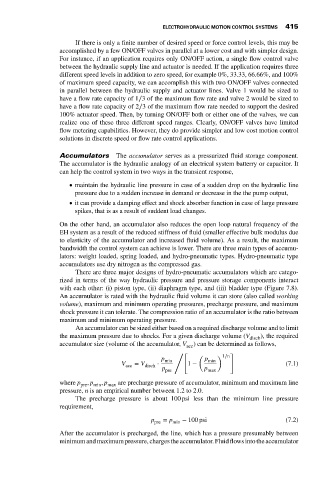Page 429 - Mechatronics with Experiments
P. 429
Printer: Yet to Come
October 9, 2014 8:41 254mm×178mm
JWST499-c07
JWST499-Cetinkunt
ELECTROHYDRAULIC MOTION CONTROL SYSTEMS 415
If there is only a finite number of desired speed or force control levels, this may be
accomplished by a few ON/OFF valves in parallel at a lower cost and with simpler design.
For instance, if an application requires only ON/OFF action, a single flow control valve
between the hydraulic supply line and actuator is needed. If the application requires three
different speed levels in addition to zero speed, for example 0%, 33.33, 66.66%, and 100%
of maximum speed capacity, we can accomplish this with two ON/OFF valves connected
in parallel between the hydraulic supply and actuator lines. Valve 1 would be sized to
have a flow rate capacity of 1∕3 of the maximum flow rate and valve 2 would be sized to
have a flow rate capacity of 2∕3 of the maximum flow rate needed to support the desired
100% actuator speed. Then, by turning ON/OFF both or either one of the valves, we can
realize one of these three different speed ranges. Clearly, ON/OFF valves have limited
flow metering capabilities. However, they do provide simpler and low cost motion control
solutions in discrete speed or flow rate control applications.
Accumulators The accumulator serves as a pressurized fluid storage component.
The accumulator is the hydraulic analogy of an electrical system batterry or capacitor. It
can help the control system in two ways in the transient response,
maintain the hydraulic line pressure in case of a sudden drop on the hydraulic line
pressure due to a sudden increase in demand or decrease in the the pump output,
it can provide a damping effect and shock absorber function in case of large pressure
spikes, that is as a result of suddent load changes.
On the other hand, an accumulator also reduces the open loop natural frequency of the
EH system as a result of the reduced stiffness of fluid (smaller effective bulk modulus due
to elasticity of the accumulator and increased fluid volume). As a result, the maximum
bandwidth the control system can achieve is lower. There are three main types of accumu-
lators: weight loaded, spring loaded, and hydro-pneumatic types. Hydro-pneumatic type
accumulators use dry nitrogen as the compressed gas.
There are three major designs of hydro-pneumatic accumulators which are catego-
rized in terms of the way hydraulic pressure and pressure storage components interact
with each other: (i) piston type, (ii) diaphragm type, and (iii) bladder type (Figure 7.8).
An accumulator is rated with the hydraulic fluid volume it can store (also called working
volume), maximum and minimum operating pressures, precharge pressure, and maximum
shock pressure it can tolerate. The compression ratio of an accumulator is the ratio between
maximum and minimum operating pressure.
An accumulator can be sized either based on a required discharge volume and to limit
the maximum pressure due to shocks. For a given discharge volume (V disch ), the required
accumulator size (volume of the accumulator, V acc ) can be determined as follows,
/[ ]
( ) 1∕n
p min p min
V = V ⋅ 1 − (7.1)
acc disch
p p
pre max
where p pre , p min , p max are precharge pressure of accumulator, minimum and maximum line
pressure, n is an empirical number between 1.2to2.0.
The precharge pressure is about 100 psi less than the minimum line pressure
requirement,
p pre = p min − 100 psi (7.2)
After the accumulator is precharged, the line, which has a pressure presumably between
minimum and maximum pressure, charges the accumulator. Fluid flows into the accumulator

